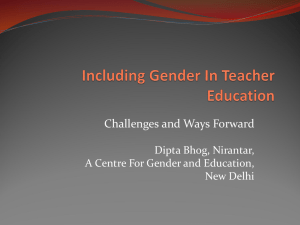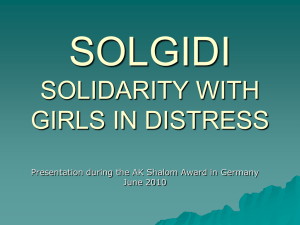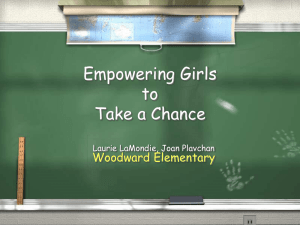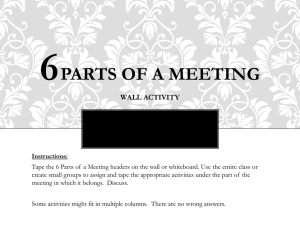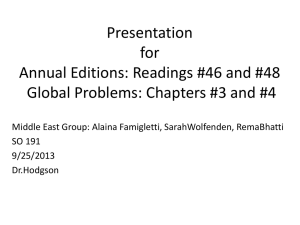Kanayashree Prakalpa Scheme of West Bengal
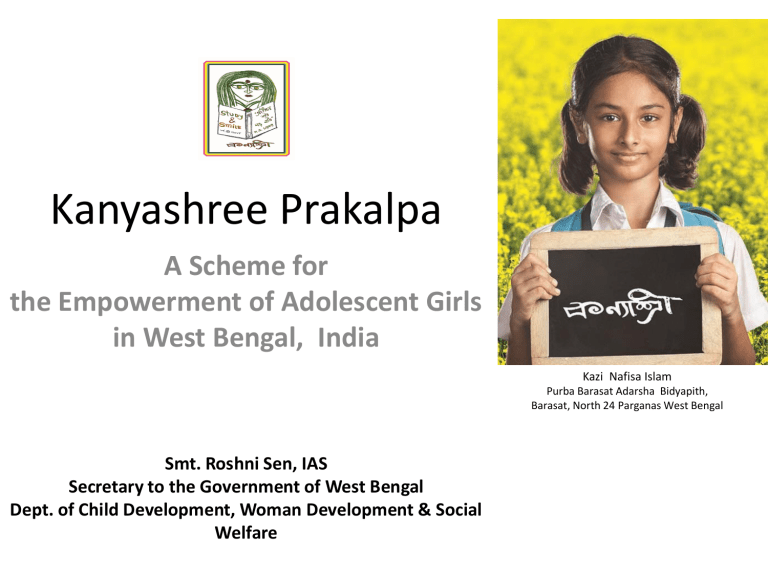
Kanyashree Prakalpa
A Scheme for the Empowerment of Adolescent Girls in West Bengal, India
Kazi Nafisa Islam
Purba Barasat Adarsha Bidyapith,
Barasat, North 24 Parganas West Bengal
Smt. Roshni Sen, IAS
Secretary to the Government of West Bengal
Dept. of Child Development, Woman Development & Social
Welfare
C
HILD
M
ARRIAGE
I
N
W
EST
B
ENGAL
•
• (DLHS-3, 07-08)
– 5 th highest prevalence
– 54.7
% ( women aged 20-24 years are married before the completion of 18 )
• Gendered practice – significantly more girls than boys affected
Also prevalent in urban areas
DLHS 4 (2012 -13)
32.1% ( of girls aged 18 years currently getting married before 18 years )
Negative Impact of child marriage
• Poor retention of girls in education
• Early pregnancies, maternal and child ill-health and mortality, life-long health implications
• Child marriages are a conduit for trafficking
• Girls are susceptible to poverty, exploitation and trafficking because of low education
• Affects not only young girls, but families, community and society
• Perpetuates generational cycles of disempowerment
• Contributes to feminization of poverty
Priya Karmakar,
Purba Barasat Adarsha
Bidyapith, Barasat,
North 24 Parganas
West Bengal
The State of West Bengal seeks to change this disabling context through Kanyashree Prakalpa, a conditional cash transfer scheme
Announced by Chief Minister on 8 th March, 2013
And launched on 1 st October 2013
A
NALYTICAL STUDY TAKES INTO ACCOUNT
• Little perceptible outcome of legal enforcement and anti-child marriage campaigns
• Effectiveness of CCT schemes in creating social safety net and in negotiating behavior change
• Rationale for promoting education as a strategy:
– Reduces probability of child marriage (UNFPA) and increases employability (World Bank)
• Analysis of shortcomings in existing CCT schemes for children in India
– Multiplicity of milestones, eligibility criteria and benefits over a protracted period of time
– Operational challenges, e.g.
• Difficulties in identifying beneficiaries,
• Poor management and communication between implementing departments,
• An unclear understanding of the scheme’s purposes at field levels,
• Delayed transfer of payments to beneficiaries, and an
• Absence of grievance mechanisms and feedback loops to inform the process.
• No evaluative processes
D
ESIGN
C
OMPONENTS
& S
TRATEGY
Conditional Cash Transfer
Component 1 : Annual scholarship of INR 500 to unmarried girls aged 13-18 years enrolled in Grades VIII-XII or equivalent
Component 2 : One-time grant of INR 25,000 to unmarried girls aged 18 years pursuing education, vocational / technical training / sports
Banking: Zero-balance bank accounts in girls names, simplified opening procedures, direct transfer of funds
• Discourages child marriage
• Incentivizes education
• Ensures Financial inclusion
• Promotes social power and self esteem of girls
Innovative Communication strategy
Applicable for girls whose family income of not more than INR. 120,000 per annum.)
No family income bar for girls with special needs / who have lost both parents / residing in J.J. homes
Certification by local authorities
E
FFICIENT
S
ERVICE
D
ELIVERY
M
ECHANISMS
Designed for accessibility & speed
One-window service delivery Application forms available in schools, enrollment and bank account opening facilitated by schools
Application, scrutiny and sanctioning through e-portal reduces paperwork and increases the response time at each node of the process
Scrutiny of eligibility criteria Monthly random-sample scrutiny
Unique ID for each beneficiary Renewals annual scholarships and for the onetime grant at age 18 will be facilitated through the beneficiary’s data already available on the portal.
T
ARGETED COMMUNICATION STRATEGY
Documented communication strategy with components of public advocacy and behavior change methods
• Awareness through
– Schools & other institutions
– Mass media & celebrity endorsement, and traditional formats such as melas, street theatre
• Kanyashree Day at state, district and block levels, with girls achievers being felicitated
• Kanyashree movement through
– events, poetry writing competitions etc
– Kanayshree clubs
– methods that attract young girls such as specially designed bangles, ID cards,
– a pledge
• Publicized by various government departments
– ASHA newsletters (Dept of Health & Family
Welfare)
– At libraries of Dept of Mass Education
– Advertisements of Consumer Affairs Dept -
C
ELEBRITY ENDORSEMENT
C
ONVERGENT
D
EVELOPMENT
& I
MPLEMENTATION
Government, banking sector & social sector
Department of Woman Development and Social Welfare Nodal department
Department of Finance, Departments of School
Education, Higher Education and Technical Education and
Training, Minority Affairs & Madrasah Education
Department of Mass Education Extension and Library
Services, Panchayat and Rural Development, Municipal
Affairs, , Department of Health and Family Welfare,
Information and Cultural Affairs, Sports & Youth Services
Banking sector
NIC West Bengal
Key partner departments
Promoting and supporting the scheme in their own domains
Opening of zero-balance accounts and disbursement of funds
E-governance
UNICEF Office for West Bengal
Private sectors
NGOs at the grassroots
Technical support
JWT India, Nielson India P. Ltd, distribution of bicycles to beneficiaries
Encouraging enrollments, developing
Kanyashree clubs etc
M
ANAGEMENT
& M
ONITORING
S
TRUCTURES
Management
State Project
Management Unit
State
Monitoring
Steering and Monitoring
Committee chaired by Hon’ble
Finance Minister
District Level Project
Management Units
• Block level units
• Schools & other educational institutions
District
Block & grass-roots
•
Steering and Monitoring
Committees chaired by DMs
Steering and Monitoring
Committees chaired by BDOs
• Schools & other educational institutions
• Continual communication through video conferences, feedback based on analysis of MIS data
• Responsive action on grievances in application form distribution, enrollment and remittances through interaction of ground level field implementers and beneficiaries.
• State, district and block and district level officials monitor the performance of schemes, and continually refine processes to work around area-specific challenges
O
NE
W
INDOW ONLINE
M
ANAGEMENT
P
ORTAL
• The entire scheme is enabled through a dedicated online portal
– Enrollment
– Scrutiny
– Sanctioning of applications
• Serves as a real-time reporting system
• Ensures transparency, efficiency and zero leakage
• Has a feedback mechanism
C
APACITY BUILDING
• All significant stakeholders – district and block level officials and school personnel provided training
• Teachers
• BDOs, BIOs, DIOs
• Elected reps
• SI / DI of schools
• Data managers, etc
• Pool of 89 master trainers created
• Refresher trainings will continue as the scheme’s implementation is being streamlined.
All implementing stakeholders follow the
Scheme’s
Implementation Guidelines
Version 1.0, with a second version being currently drafted.
S
USTAINABILITY
• Low administrative cost – high impact
– Administrative and publicity budget : Rs. 67 crores, approx. 10% of the estimated Rs. 600 crores disbursement to beneficiaries.
• GoWB views expenditure incurred as an investment in the education of adolescent girls.
– Flagship scheme of the government, and is entirely state-government funded
– Rs. 700 crores earmarked by West Bengal government despite financial crunch
Political ownership, leadership and commitment from the top, and huge response from the bottom-up has made the scheme vibrant and sustainable
R
EPLICABLE IN ITS ENTIRETY
• Single point of service-delivery: schools & other educational institutions – where target recipient is enrolled
• Implemented & monitored through existing government machinery
• End-to-end IT enabled
• Has a comprehensive implementation guidelines and a documented communication strategy which can be periodically updated
N
O
.
OF
B
ENEFICIARIES
( 2013-2014)
2 100 000
2 000 000
1 900 000
1 800 000
1 700 000
1 600 000
1 500 000
Nos.
1 682 471
Nos.
1 983 673
Targeted Enrolled
Over 19.8 lakh applications received
Over 18.3 lakh applications sanctioned
Nos.
1 833 378
Sanctioned
118% of target applications received
92.4 % applications sanctioned
I
MPACT
A
SSESSMENT
• A baseline survey is being undertaken with the support of UNICEF
– Key result areas being monitored are Education indicators
• Marriage indicators
• Implementation indicators
– Report due in December, 2014
• Midline study to be held 3 years after baseline study
Acknowledged as a ‘good practice’
Girl Summit 2014
(Department for International Development, UK and UNICEF in London. )
Beti Bachao, Beti Padhao’ Scheme
Ministry of Women and Child Development, India
R
APID
A
SSESSMENT
(UNICEF, S
EPT
2014)
School attendance rate has improved from 72% in 2011-12 to 75% in 2013-14.
75,5
75
74,5
74
73,5
73
72,5
72
71,5
71
70,5
72 72
75
2011-12 2012-13 2013-14
Child marriage numbers have declined from 73 identified cases in 2012-13 to
54 cases in 2013-14.
Financial inclusion
• Approximately 10,286 new bank accounts were opened for the beneficiaries of the scheme by the school authorities.
R
APID
A
SSESSMENT
(UNICEF, S
EPT
2014)
Some receipients of the one-time grant:
North 24 Parganas (Nabapally Jogendranath Balika Bidyamandir (Barasat- I)
Monami Chakraborty - Class XII
Daughter of truck driver, was looking for a loan so that she could study medicine.
Champa Gayen Class XI
Works as a domestic help while educating herself. Used some of the money to buy a bag, and pay her tuition fees
Sonali Das, ex-student, now in college
Family was pressurizing her to give up studying after Class XII.
Now in college in Bengali
Honours, wants to do her B. Ed
W
AY
F
ORWARD
Key strength: Dynamism
• Core design simple - lends itself to vertical and horizontal growth
• Focus on continuous improvement for efficiency and accountability
Current areas of development
• E-Portal being integrated with CPFMS for better financial management & effective fundflow
• Digital Certificates, USB e-Tokens and SSL
Certificates for greater quality assurance and accountability
• Strengthening grievance mechanisms
• Reservation of seats for vocational training, priority in polytechnic girls’ hostels & reduction of fees for admissions and counselling
• Linkages with stakeholders such as CSR
“Our child now has a foundation – we have hope that she can stand on her own feet”
Voices of parents
Rapid Assessment, (UNICEF 2014)
Several years of sustained implementation are expected to bring about a discernable change in the status of the state’s girls and women.
Rimpi Debnath
Purba Barasat
Adarsha
Bidyapith,
Barasat, North
24 Parganas
West Bengal

